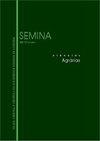食品工业用转基因和常规玉米杂交品种籽粒农艺性状和物理性状的相关性和对比
IF 0.5
4区 农林科学
Q4 AGRICULTURE, MULTIDISCIPLINARY
引用次数: 0
摘要
食品工业对高产原料非常感兴趣,以丰富和开发新的产品,为人们提供负担得起的价值。本研究旨在确定常规和转基因玉米杂种在第一季籽粒物理性状和农艺性状之间的相关性和对比。试验设置于瓜拉普瓦- PR地区2017/18、2018/19和2019/20三季,采用随机区组设计,设置8个杂交品种(SUPREMO VIP、SUPREMO、P30F53VYH、P30F53、P3456H、P3456、DKB290PRO3和DKB290), 3个重复。评价了腐粒率、千粒重、籽粒产量等农艺性状和工业用籽粒粒度、胚芽、玻璃体、浮力、百升重等物理性状。砂砾与浮选呈正相关关系。在食品工业中,选择基于玻璃体的混合材料有利于浮选。粗粒与百升重呈显著正相关,与腐粒发生率呈显著负相关。玻璃性受常规或转基因杂交品种和作物季节的影响。季节环境对常规玉米和转基因玉米杂交种的产量、千粒重和腐粒率均有影响。本文章由计算机程序翻译,如有差异,请以英文原文为准。
Correlation and contrasts between agronomic and physical traits of grain in transgenic and conventional corn hybrids for the food industry
The food industry is very interested in high-yield ingredients to enrich and develop new products that have an affordable value for the population. This work aimed to determine the correlations and contrasts between grain physical and agronomic traits of conventional and transgenic corn hybrids cultivated in the first crop season. The experiments were installed in the 2017/18, 2018/19, and 2019/20 crop seasons in Guarapuava - PR. The experimental design was a randomized block design with eight hybrids (SUPREMO VIP, SUPREMO, P30F53VYH, P30F53, P3456H, P3456, DKB290PRO3, and DKB290) and three replications. The agronomic traits, such as the percentage of rot grains, 1000-grain mass, and grain yield, also the physical traits of grains for industrial purposes, such as grits, germ, vitreousness, flotation, and hectoliter weight, were evaluated. There is a positive correlation between grits and flotation. The choice of hybrids for the food industry based on vitreousness positively favors flotation. The grits showed a positive correlation with hectoliter weight and a negative correlation with the incidence of rot grains. Vitreousness was influenced by the choice of conventional or transgenic hybrid and crop season. The environments of the crop seasons influence the grain yield, 1000-grain mass, and rot grain incidence of conventional and transgenic corn hybrids.
求助全文
通过发布文献求助,成功后即可免费获取论文全文。
去求助
来源期刊

Semina-ciencias Agrarias
农林科学-农业综合
CiteScore
1.10
自引率
0.00%
发文量
148
审稿时长
3-6 weeks
期刊介绍:
The Journal Semina Ciencias Agrarias (Semina: Cien. Agrar.) is a quarterly publication promoting Science and Technology and is associated with the State University of Londrina. It publishes original and review articles, as well as case reports and communications in the field of Agricultural Sciences, Animal Sciences, Food Sciences and Veterinary Medicine.
 求助内容:
求助内容: 应助结果提醒方式:
应助结果提醒方式:


